Plauen Branch, Zwickau District
Roger P. Minert, In Harm’s Way: East German Latter-day Saints in World War II (Provo, UT: Religious Studies Center, Brigham Young University, 2009), 488-93.
The city of Plauen in Saxony was located in the extreme southwest corner of the East German Mission territory. The city is twenty-four miles southwest of Zwickau and had a population of about 130,000 people when the war began.
| Plauen Branch[1] | 1939 |
| Elders | 8 |
| Priests | 1 |
| Teachers | 0 |
| Deacons | 8 |
| Other Adult Males | 31 |
| Adult Females | 114 |
| Male Children | 6 |
| Female Children | 2 |
| Total | 170 |
Plauen was the home of a very strong branch of The Church of Jesus Christ of Latter-day Saints in 1939. The history of the East German Mission has several entries regarding the rooms in which the Plauen Branch met:
Thursday, September 1, 1938: The Plauen Branch, Zwickau District, moved temporarily into a new hall at Rahnitzer Strasse 103.[2]
November 1938: During the month of November, various improvements took place in the Plauen Branch. Among other things the stage was rebuilt, a wall replaced, a banister remodeled.[3] During the month of January [1939], the meeting hall in the Plauen Branch, Zwickau District, was completely renovated.[4]
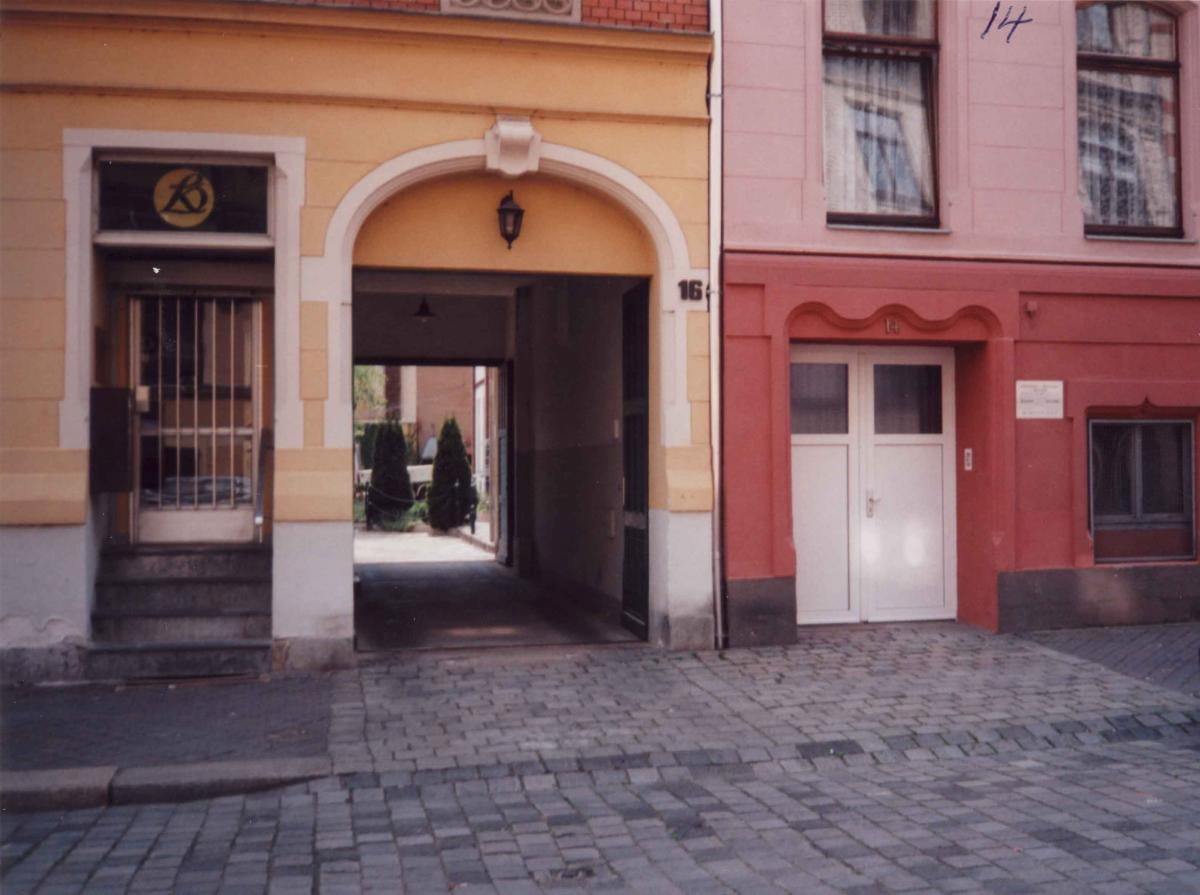 To reach the branch meeting rooms in Plauen, members walked through this portal to the Hinterhaus. (F. Fassmann)
To reach the branch meeting rooms in Plauen, members walked through this portal to the Hinterhaus. (F. Fassmann)
The mission history also gives evidence that the Plauen Saints enjoyed interacting with the members of other nearby branches. We read this entry under Sunday, October 16, 1938:
Members of the Zwickau, Werdau, and Wilkau[-Hasslau] Branches made a trip by bus to Aschberg. A special meeting was held in Schwarzenberg in the morning and one in Plauen in the evening. Fifty percent of the members participated.[5]
As is true throughout all the Zwickau District, the Plauen Branch also had a prominent group of adult women (all 67 percent of the branch population).
Perhaps the best source of information on the Plauen Branch is the journal kept by branch member Louis Christian Fassmann (born 1889). Along with stories of events in the branch and records of branch members, priesthood ordinations, mission and district leaders, family tithing payments and statistics, he kept a record of all of the full-time missionaries who served there. For example, he recorded the departure of elders Ralph H. Kmetzsch and Parry H. Harryson on August 26, 1939, due to “danger of war.” They were replaced that day by one German missionary, Ernst Landschulz, who stayed in Planitz until November 24, 1940.[6]
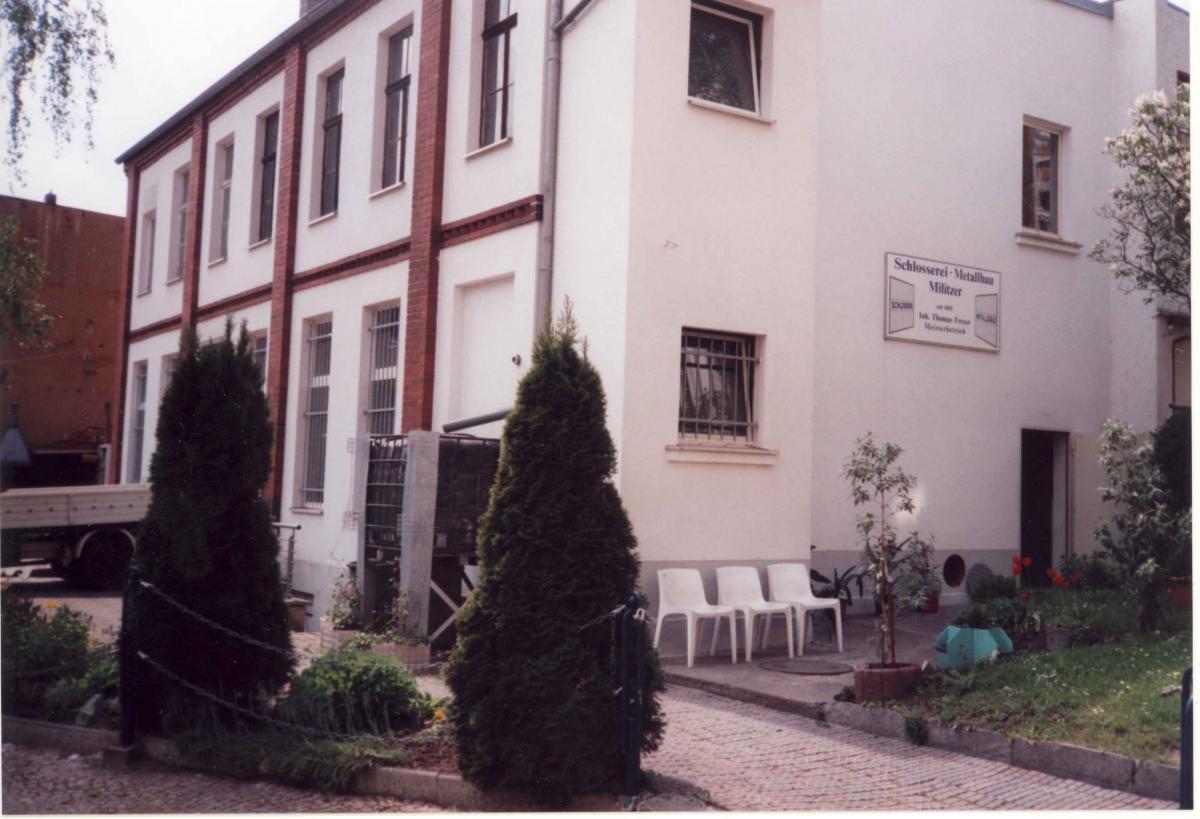 A modern view of the Hinterhaus at Beethovenstrasse 14, which served the branch from 1942 through the end of the war (F. Fassmann)
A modern view of the Hinterhaus at Beethovenstrasse 14, which served the branch from 1942 through the end of the war (F. Fassmann)
By January 1943, the mission directory showed a different address for the Plauen Branch, namely Beethovenstrasse 14. Fritz Fassmann (born 1927) recalled moving into the rooms at Beethovenstrasse near the onset of the war and meeting there into the postwar era. He also recalled going to church early to heat the rooms so that there would be a comfortable temperature by the time most of the members arrived.[7]
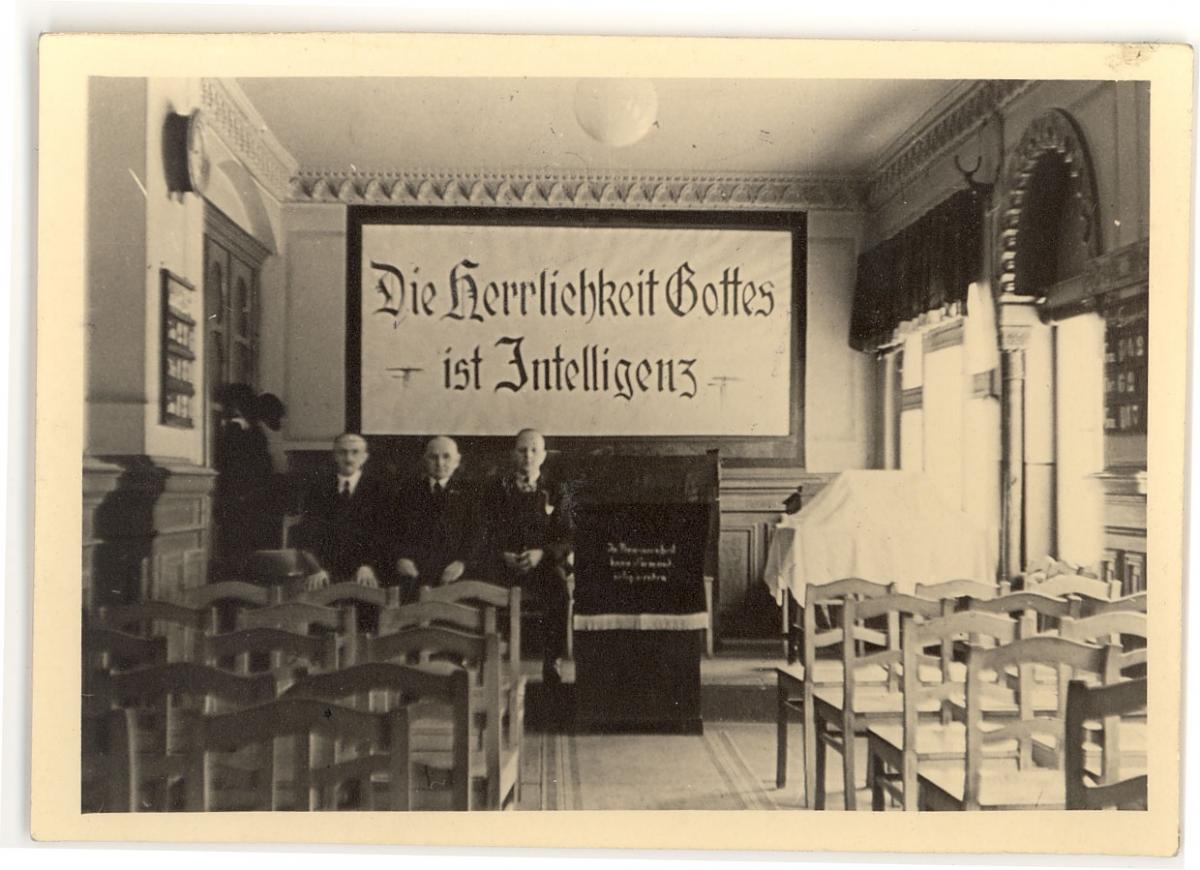 The chapel of the Plauen Branch during World War II. At left is Louis Christian Fassmann, the author of the branch records. The banner reads, “The Glory of God Is Intelligence.” (F. Fassmann)
The chapel of the Plauen Branch during World War II. At left is Louis Christian Fassmann, the author of the branch records. The banner reads, “The Glory of God Is Intelligence.” (F. Fassmann)
Ruth Pfund (born 1931) provided the following description of the rooms at Beethovenstrasse: “The meeting rooms were located in a Hinterhaus. The branch was not very large, but we had a comfortable and large meeting room. There was one large room and two or three smaller rooms. It was decorated very simply.”[8]
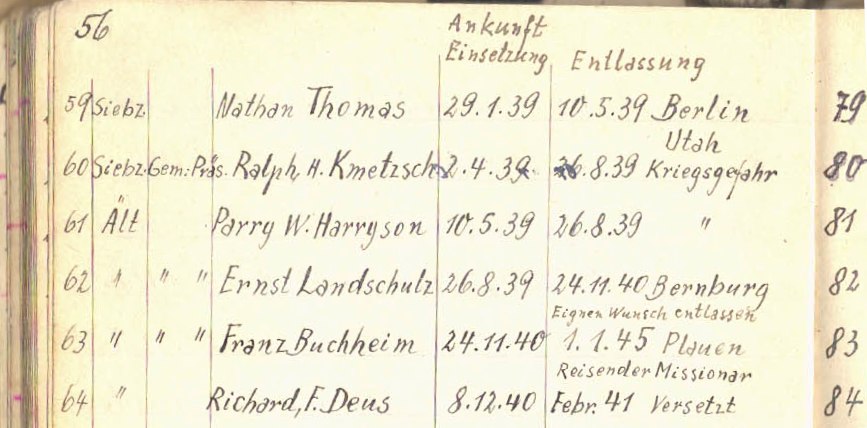 A page of Louis Christian Fassmann’s journal showing the comings and goings of full-time missionaries in Plauen (F. Fassmann)
A page of Louis Christian Fassmann’s journal showing the comings and goings of full-time missionaries in Plauen (F. Fassmann)
Fritz Fassmann also recalled attending Church meetings on occasion in his Hitler Youth uniform. “Sometimes when we had [Jungvolk] meetings on Sunday mornings, we went over to church in our uniforms. . . . I know of one brother who was in the Sturmabteilung [SA] because of his occupation. Sometimes he came to Sunday School in his uniform.”[9]
Fritz’s elder sister, Irmgard (born 1924), served her Pflichtjahr at the age of fifteen (from April 1939 to April 1940). She was sent with twenty-four other girls her age to work on a farm in eastern Silesia. Her day began at five o’clock, and she spent the morning feeding and milking cows, cleaning stalls, feeding chickens, collecting eggs, turning hay, planting potatoes, and doing other farm chores. The conclusion of the day was apparently the most entertaining:
We worked till six at night, ate again, and at 8:00 we girls could go back to our camp. The camp was fun, too. We girls had a lot to giggle [about] and tell about our experiences and then fell dead tired into bed. . . . During this time I could not go to my church so I sent my tithing home. We got about 20.00 marks a month. When I started . . . I was a skinny little thing, but after this year on the farm, I grew strong and big. I was able to carry a 100 lb. bag of wheat to the miller some houses away.[10]
World War II began while Irmgard was working on the farm. At age sixteen, she finished school and signed up for a secretarial course sponsored by the Junkers Aircraft Company of Dessau. After three months of office training, she was hired and moved to Dessau. Her wage at Junkers was 120 marks a month. In Dessau, she could not find the branch of Latter-day Saints, so she hummed Church melodies on the bus and thereby met Brother Gerstner. She recalled, “The next Sunday I went to church. I was surprised at how small the branch was, only about twelve people present.” She remained in Dessau until the last year of the war.
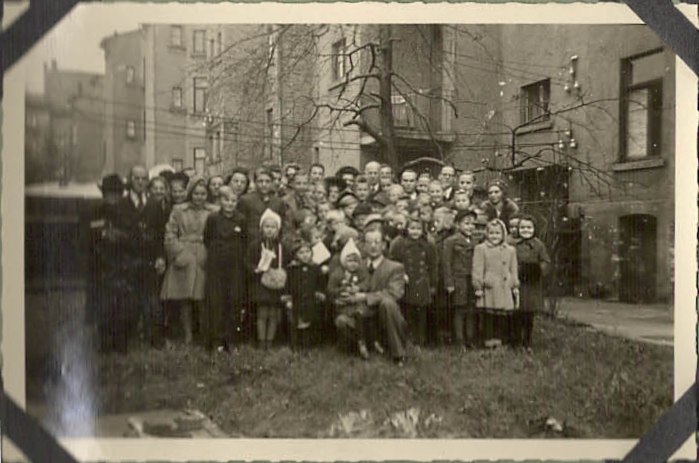 Members of the Plauen Branch posed for the photographer between the main building at Beethovenstrasse 14 (right) and the Hinterhaus where they met (to the right). (F. Fassmann)
Members of the Plauen Branch posed for the photographer between the main building at Beethovenstrasse 14 (right) and the Hinterhaus where they met (to the right). (F. Fassmann)
According to Fritz Fassmann, life in Plauen did not change much during the first years of the war. “Our daily lives were normal for us. The adults worked or did something at home, while the children were at school or participated in extracurricular activities.” Air raids and invading armies were experiences of the last year of the war in Plauen.
Toward the end of the war, Fritz Fassmann was inducted into the Reichsarbeitsdienst and sent to Czechoslovakia to work. While he was there, his time elapsed and as was common practice at the time, he was automatically drafted into the army. While still in Czechoslovakia for training, he and his unit were captured by the invading Red Army in April 1945.
The diary of Louis Christian Fassmann contains a list of all members of the Plauen Branch, as well as a record of current events. No fewer than fifteen members died during the war, including several who were killed in air raids over Plauen. The last few days of the war in Plauen were perilous times in that large city while the residents were being bombed into submission by the Allies:
Air raids day and night.
February 23, March 5, 1945: Little damage.
March 19, 1945: day time air raid; windows damaged.
March 21, 1945: terrible attack; everything bombed out; our house is totally destroyed.
March 25, 1945: had regular [Sunday] meetings.
March 26: huge raid with incendiary bombs; both of us were hiding in a bomb crater outside and were showered by debris and suffered bruises; I suffered a broken rib; we moved to the home of Sister Wunderlich at Bahnhofstrasse 84 until April 10, 1945.
April 1, 1945: held regular meetings, with branch president Erich Sellner of Werdau in attendance.
April 3, 1945: night attack.
April 8, 1945: Sunday night air raid; alarms prevented us from holding meetings.
April 9, 1945: night air raid; city center on fire.
April 10, 1945: huge air raid; worst attack yet; city center and Haselbrunn [neighborhood] all burned out; incendiaries; only 55,000 people left in Plauen; it is a ghost town; almost all of the members have been bombed out or burned out. Most of the members are living out of town.
Spent a night in the Schönfeld home at Rossviertelstrasse 10.
April 12, 1945: stayed in the home of a farmer named Wenk in Trieb.
April 15, 1945: no meetings. Our rooms are slightly damaged. Plaster has fallen from the ceiling and window panes are broken.
April 22, 1945, Sunday: we were at church; windows are all right; no meeting because of bad weather; we have to clean up first; things are not in order; Sister Ellie Kurzendörfer cleaned up the rooms.
Many members have left town. Nobody can get into or out of the city. We plan to meet on Sunday, April 29, 1945 at 3 o’clock.
I have to report to work every day.
April 29, 1945: Six persons were in attendance; the meetings were cancelled because of bad weather.
May 6, 1945: first meeting, fast meeting. District president Walter Fassmann and branch president Erich Sellner [of Werdau] were in attendance.
Brother Fassmann’s daughter, Irmgard, arrived home from Dessau on Pentecost Sunday, six weeks after Easter in 1945. She and two friends went to church and on the way saw two elderly people walking, the woman helping the man climb the hill. “Coming closer I saw that they were my parents going to church, true and faithful. I cried to see them alive even though not too strong. We got to church and . . . had a very good reunion. . . . We [were] like a real family, the whole branch.”
The Fassmanns continued to live in the apartment that was half destroyed by the bombs. “It was difficult to climb up the broken stairway, but we made it,” Irmgard recalled. Soon she went to work helping to clear the rubble from the streets.
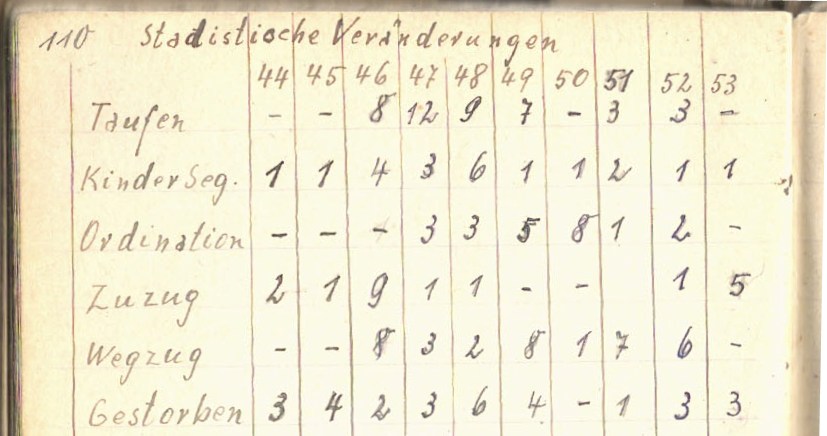 This page from Louis Christian Fassmann’s journal shows “statistical changes” in the Plauen Branch beginning in 1944. The categories are baptisms, blessings of children, ordinations, arrivals, departures, and deaths. (F. Fassmann)
This page from Louis Christian Fassmann’s journal shows “statistical changes” in the Plauen Branch beginning in 1944. The categories are baptisms, blessings of children, ordinations, arrivals, departures, and deaths. (F. Fassmann)
Fritz Fassmann had heard rumors that his Soviet captors might ship German POWs to Siberia to work and decided that “I did not want that to happen to me.” As a young man, he had confidence in his ability to survive and soon escaped from the Soviet POW camp. Making his way west, he surrendered to the Americans in Czechoslovakia. Conditions in the new camp were primitive, as he later explained:
The camp was just one wide field, without any fences, no buildings, and not even tents. We just lay in the field out in the open. I knew that Plauen was not very far away. I made plans to flee from there also. The Americans were pretty sure that nobody would escape, because the Czechs had the reputation of killing the Germans [they caught].
Nevertheless, Fritz escaped and made it safely home to Plauen. There he found a bombed-out city. “Although our [apartment] house was destroyed, the families living in the building had posted notes [in the ruins] telling people where they had moved to. That is how I found my family again.” It was about June 1945. Fritz assisted the surviving branch members in reconstructing the branch. Latter-day Saints who had fled the city began to come home.
In Memoriam:
The following members of the Plauen Branch did not survive World War II:
Emilie —— b. 9 Jan 1869; bp. 18 Sep 1909; m. 14 Sep 1901, —— Menicke; d. 21 Feb 1944 (L.C. Fassmann journal)
Emilie Maximiliane —— b. 11 Feb 1885; bp. 31 Jul 1926; m. 2 Aug 1913, —— Rothe; 2 children; d. heart attack 7 Mar 1942 (L.C. Fassmann journal; FHL Microfilm 271407, 1930/
August Karl Adler b. Rittersgrün, Zwickau, Sachsen 9 May 1852; son of Karl Ludwig Adler and Christiane Friederike Taubner; bp. 5 Apr 1909; m. Werdau, Zwickau, Sachsen 3 Jul 1871, Ernestine Pauline Adam; 8 children; 2m. Auerbach, Zwickau, Sachsen 6 Mar 1930, Emma Clara Krause; d. old age Plauen, Zwickau, Sachsen 24 Sep 1943 (L.C. Fassmann journal; IGI)
Martin Hermann b. 30 Apr 1897; bp. 2 Sep 1911; m. 9 Nov 1919; k. in air raid 20 Apr 1945 (L.C. Fassmann journal)
Elsa Klara Hoyer b. Plauen, Zwickau, Sachsen 2 May 1880; dau. of Bernhardt Albin Hoyer and Emilie Louise Schwinger; bp. 13 Sep 1907 or 22 Aug 1922; m. Plauen 4 Jan 1900, Franz Otto Buchheim; 5 children; d. stroke Plauen 5 Nov 1944 (L.C. Fassmann journal; IGI)
Paul Hermann Koch b. Adorf, Zwickau, Sachsen 25 Jan 1904; son of Gottfried Franz Koch and Lina Augusta Ebner; bp. 20 Mar 1926; soldier; d. Austria 16 Apr or 8 May 1945; bur. Nürnberg South Cemetery, Nürnberg, Bayern (FHL Microfilm 271380, 1935; AF; IGI; www.volksbund.de)
Gustav Emil Koenig b. Schöneck, Zwickau, Sachsen 1 Aug 1872; son of Friedrich August Koenig and Marie Louise Meyer; bp. 17 Jun 1910; ord. deacon 3 Sep 1914; m. Plauen, Zwickau, Sachsen 18 Jul 1896, Elisabeth Hirschmann; d. intestinal illness 21 or 27 Mar 1943 (L.C. Fassmann journal; IGI)
Reinhard Johannes Roeder b. Plauen, Zwickau, Sachsen 15 May 1919; son of Hans Fritz Roeder and Olga Selma Schmidt; bp. 25 Oct 1929; m. 22 Jan 1944; non-commissioned officer; k. in battle Monor, Romania 11 Nov 1944 (L.C. Fassmann journal; IGI; www.volksbund.de)
Gerhardt Paul Schieck b. Plauen, Zwickau, Sachsen 27 or 28 Oct 1910; son of Isidor Valentin Schieck and Johanna Georgine Spindler; bp. 19 Jan 1924; m. 27 Apr 1940, Elly Fischer; k. in battle 27 Jan 1945 (L.C. Fassmann journal; IGI)
Rosa Gertrud Schleicher b. Plauen, Zwickau, Sachsen 1 Dec 1900; dau. of Gotthardt Heinrich Schleicher and Anna Augusta Weiss; bp. 2 Sep 1911; m. 24 Dec 1924, —— Gerstner; d. 6 Feb 1944 (L.C. Fassmann journal; IGI; FHL Microfilm 25773, 1930/
Johanne Schleizer b. Plauen, Zwickau, Sachsen 23 Jan 1898; dau. of August Wartmann and Wilhelmine Schleizer; bp. 11 May 1911; m. 24 Feb 1923, —— Wagner; k. in air raid 10 Apr 1945 (L.C. Fassmann journal; IGI; FHL Microfilm 245291, 1930/
Wilhelmine Schleizer b. Pöhl, Zwickau, Sachsen 6 Feb 1870; dau. of August Schleizer and Wilhelmine; bp. 11 Mar 1911; m. 5 Apr 1895, —— Wartmann; k. in air raid 10 Apr 1945 (L.C. Fassmann journal; FHL Microfilm 245294, 1930/
Paul Werner Sorger b. Reichenbach, Zwickau, Sachsen 23 Dec 1911; son of Emil Otto Sorger and Martha Lina Keller; bp. 9 Jul 1930; k. in battle Eastern Front 1 Nov 1942 (L.C. Fassmann journal; IGI)
Anna Rosa Wolf b. Plauen, Zwickau, Sachsen 12 Aug 1909; dau. of Bruno Wolf and Martha Rosa Baumgaertel; bp. 31 Jul 1926; m. 25 Nov 1933, —— Hölzel; k. air raid 6 Feb 1945 (L.C. Fassmann journal; FHL Microfilm 163788, 1935 Census)
Notes
[1] Presiding Bishopric, “Financial, Statistical, and Historical Reports of Wards, Stakes, and Missions, 1884–1955,” CR 4 12, 257.
[2] East German Mission History Quarterly Reports, 1938, no. 40, East German Mission History.
[3] Ibid., no. 47.
[4] Ibid., 1939, no. 53.
[5] Ibid., 1938, no. 43.
[6] Louis Christian Fassmann, diary, 56; private collection.
[7] Fritz Louis Fassmann, telephone interview with Jennifer Heckmann in German, May 2, 2008; unless otherwise noted, summarized in English by Judith Sartowski.
[8] Ruth Pfund Adler, telephone interview with Judith Sartowski, March 5, 2008.
[9] The SA (Sturmabteilung) was the arm of the Nazi Party for adult males.
[10] Irmgard Fassmann Messina Schwarz, autobiography (unpublished); private collection.
